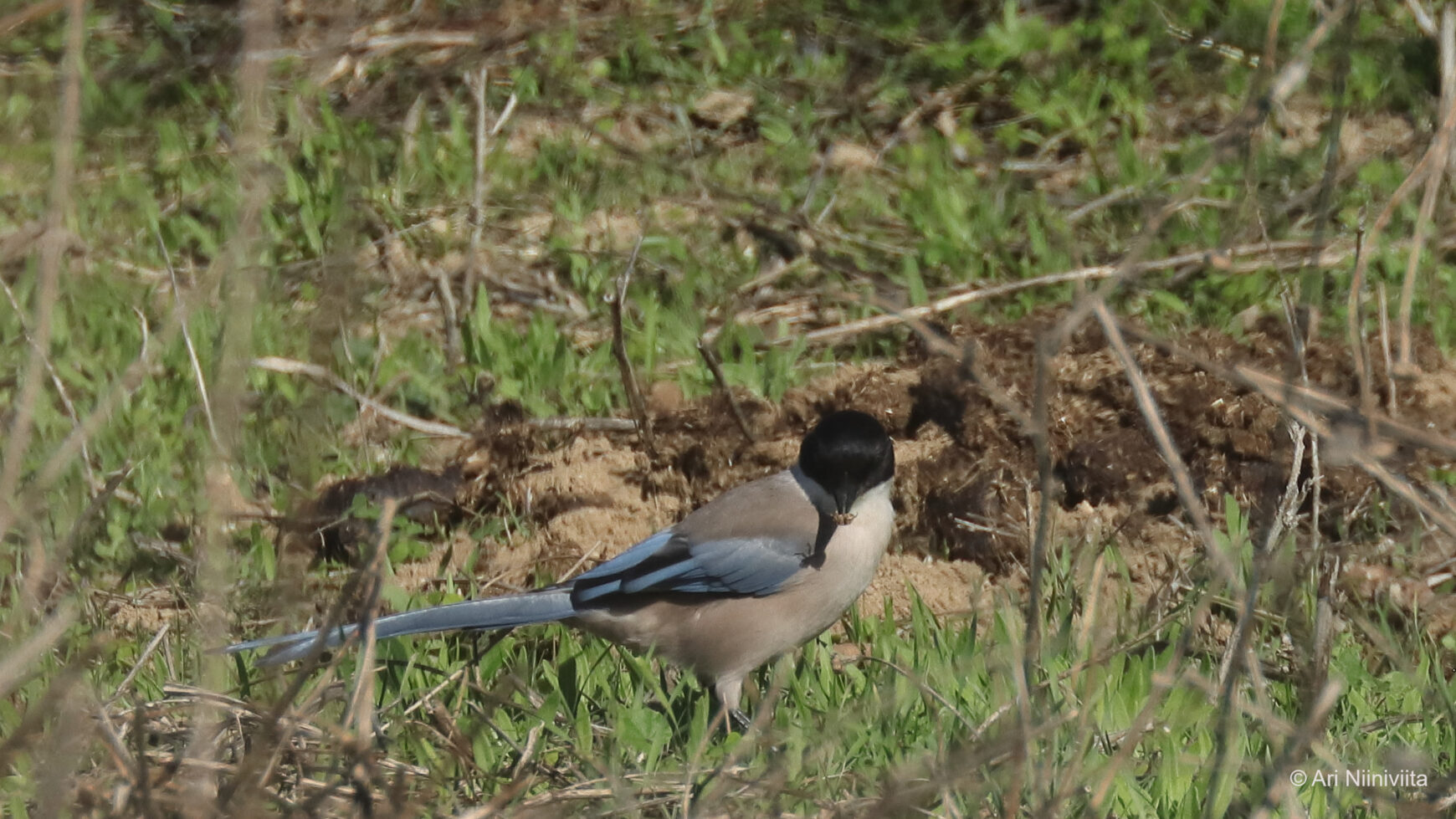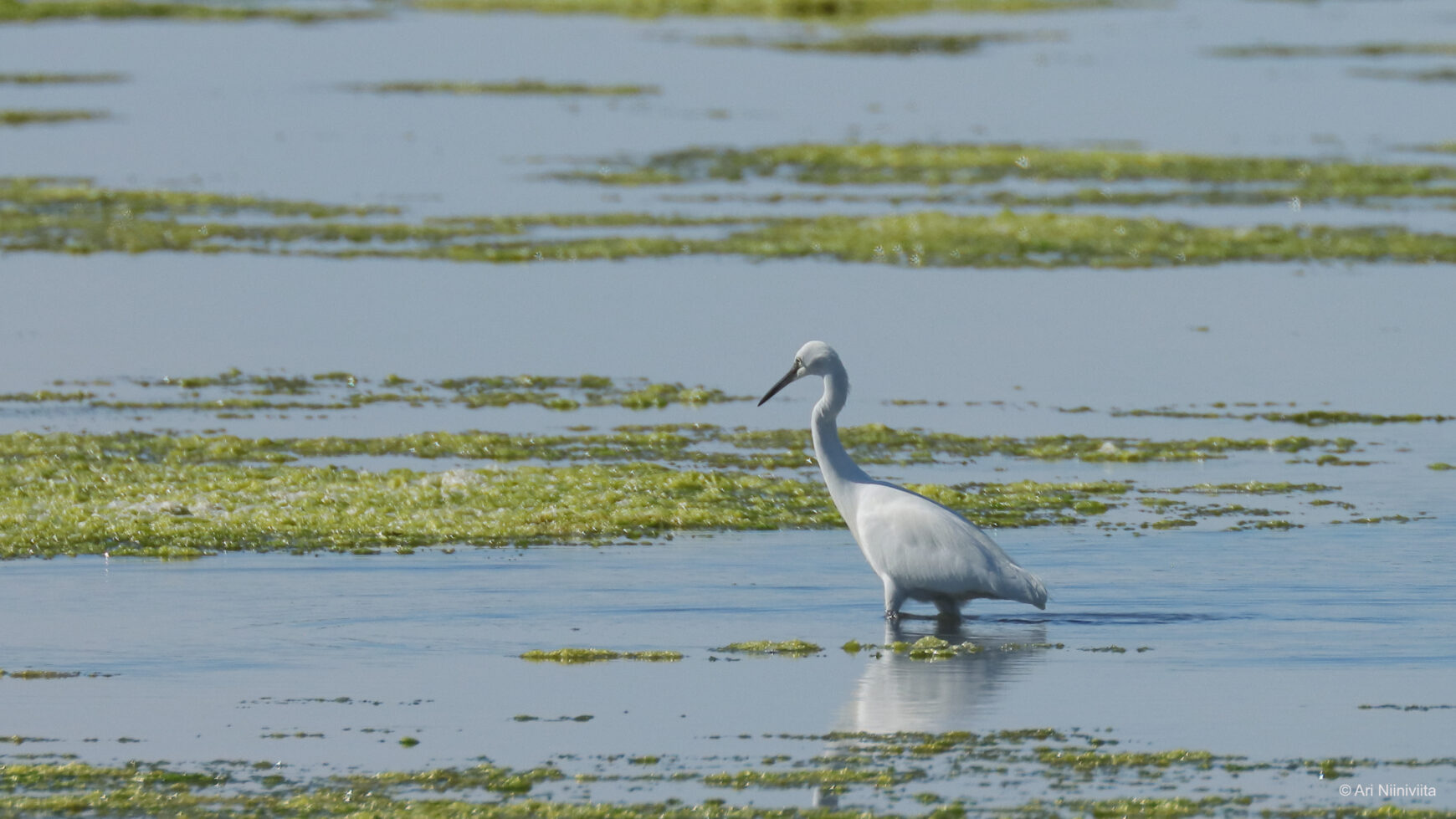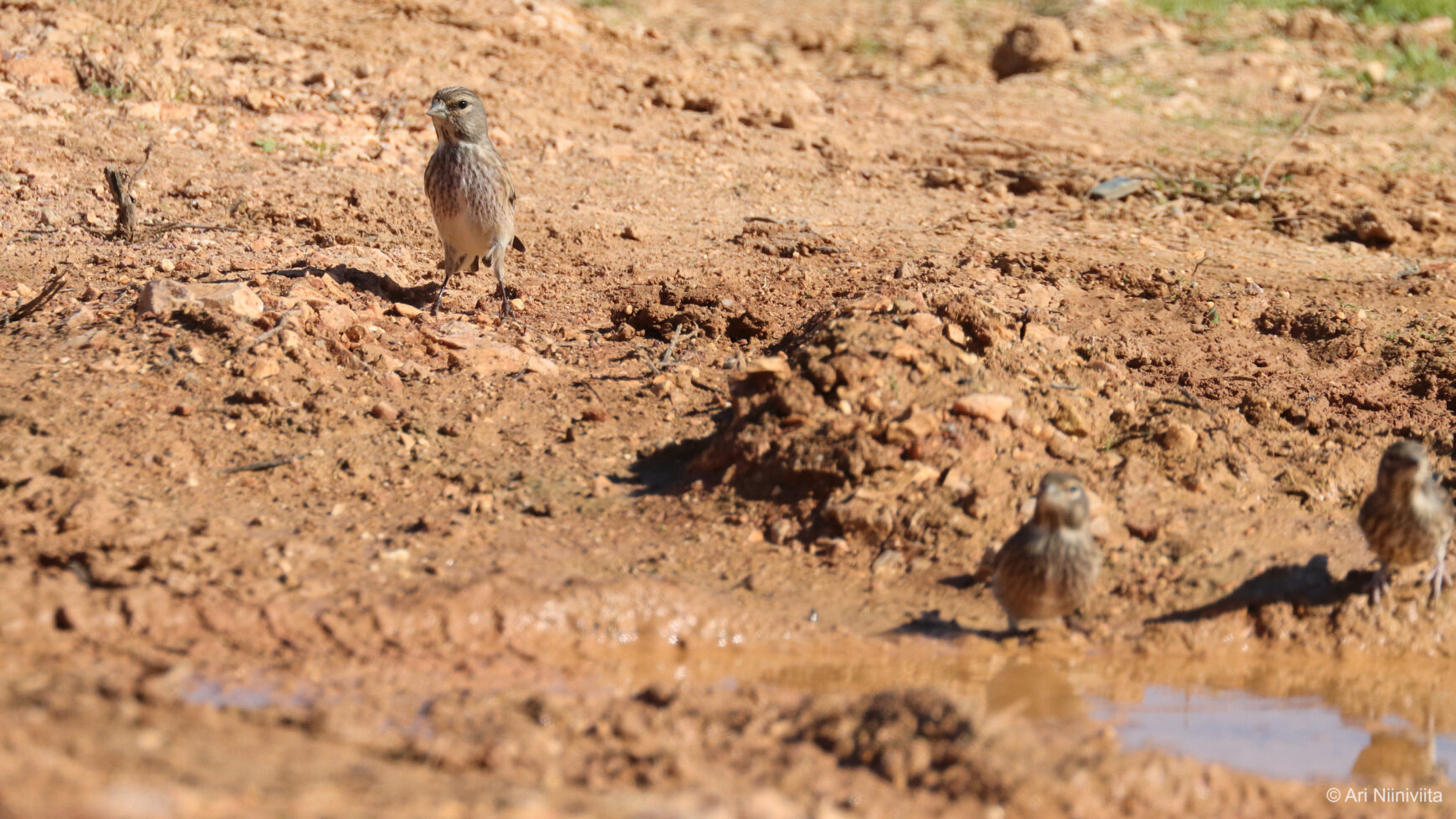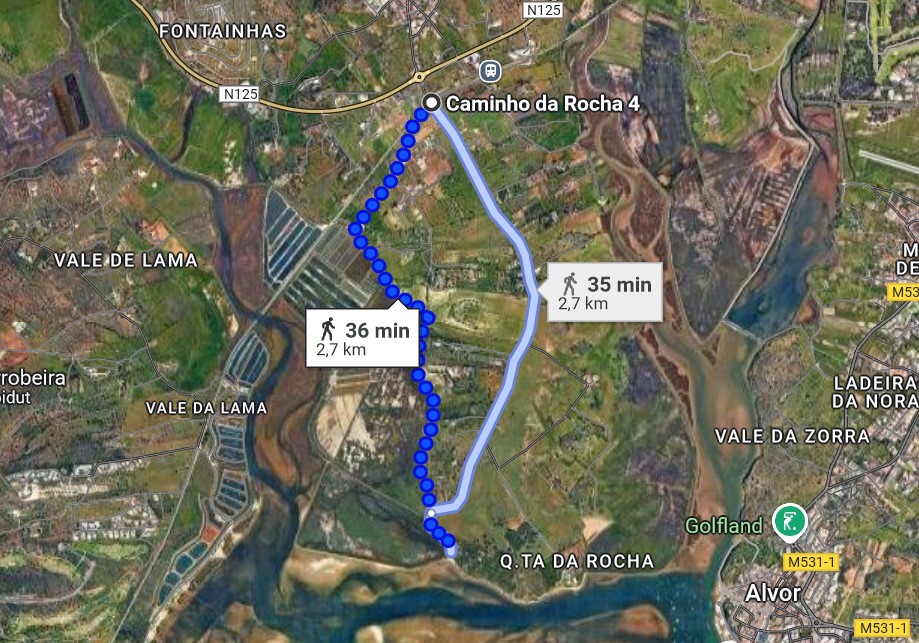Pari viikkoa sitten kävin Alvorin altailla. N125 tieltä sinne käännytään Mexilhoeira Grande Estacão liikenneympyrästä Peninan ja Lagosin välillä.
A couple of weeks ago I visited the Alvor Estuary. From the N125 road, turn off at the Mexilhoeira Grande Estacão roundabout between Penina and Lagos.
Paikka on erinomainen sekä mukavalle kävelylenkille (noin 5,5 km) että lintujen tarkkailuun. Kävellen lenkki kestää noin 1-2 tuntia riippuen kuinka paljon matkalla ihailee lintuja.
The place is excellent for both a nice walk (about 5.5 km) and bird watching. The walk takes about 1-2 hours, depending on how much bird watching you do.
Kun itse haluan keskittyä lintujen tarkkailuun ja valokuvaukseen niin valitsen aina Caminho da Espangueira tien (käännyn rautatien ylityksen jälkeen oikealle tultaessa N125 tieltä). Takaisin palaan sitten Caminho da Rocha tietä lähtöpaikkaan.
When I want to focus on bird watching and photography, I always choose the Caminho da Espangueira road (after the railway crossing, I turn right when coming from the N125 road). I then return to the starting point via the Caminho da Rocha road.
Tiellä on kaksi erittäin hyvää paikkaa katsella lintuja. Noin 1,5 km jälkeen eteen aukeaa oikealla laaja kosteikko ja varsinkin kahlaajia näkyy aina jopa aivan tien vieressä. Tämä on ensimmäinen paikka.
There are two very good places to watch birds on the road. After about 1.5 km, a large wetland opens up on the right, and waders are always visible, even right next to the road. This is the first place.
Tällä kertaa ensin kuviin pääsivät taivaanvuohet, joista yleensä on haasteellista saada hyvää kuvaa, kun niillä on melkein aina nokka vedessä etsimässä ruokaa.
This time, the first to be photographed were the Common snipes, which are usually challenging to get a good picture of as they almost always have their beaks in the water looking for food.


Tällä paikalla voi helposti havaita toistakymmentä eri kahlaajalajia muutamassa minuutissa.
At this location, you can easily spot a dozen different species of waders in a few minutes.
Punajalkavikloja näkyi myös huomattavan paljon. Tässä yksi, joka suostui olemaan tarpeeksi lähellä valokuvattavaksi.
There were also a considerable number of Common redshanks. Here is one that agreed to be close enough to be photographed.

Yksi suosikki kahlaajalintujani on tylli, joka usein seisoo täysin liikkumatta paikallaan tai sitten pikku hiljaa siirtyy paikasta toiseen. Tänään näkemäni oli liikkuvampaa muotoa eli se katseli ympärilleen ja siirtyi 20 senttiä, oli hetken paikallaan ja taas siirtyi 20 senttiä eteenpäin. Valokuvaajalle mitä otollisin kohde kuvattavaksi.
One of my favorite wading birds is the Common ringed plover, which often stands completely still in one place or then slowly moves from one place to another. The one I saw today was more mobile, meaning it looked around and moved 20 centimeters, stood still for a moment and moved 20 centimeters forward again. A very pleasant subject for a photographer to photograph.

Sitten oli aika siirtyä tietä pitkin eteenpäin ja pysähdyin toiselle hyvälle paikalle nimeltään Flamingojen katselupaikka, kun tielle lennähti töyhtökiuru. Se on todella yleinen lintu Algarvessa ja viihtyy kuivilla alueilla. Tälläkin kertaa se hyppeli hetken tien laidassa ja sitten lensi pois.
Then it was time to move on along the road and I stopped to the second good place called Flamingo view point, when a Crested lark flew onto the road. It is a very common bird in the Algarve and thrives in dry areas. This time too it hopped for a moment on the side of the road and then flew away.

Nimensä mukaisesti tällä paikalla usein näkee jopa muutaman kymmenen flamingon parvia. Tänään ei näkynyt yhtäkään.
As the name suggests, flocks of up to a few dozen flamingos can often be seen at this spot. Today, not a single one was seen.
Mutta eipä tarvinnut kuin katsoa selän taakse, niin siellä lehmälaitumella lenteli siniharakka, joka päätti hetkeksi jäädä kaivelemaan matoja maasta. Se on eri värinen kuin suomalainen harakka, mutta kuitenkin yhtä värikäs.
But all I had to do was to look behind me and there was an Iberian magpie flying over the cow pasture, deciding to stay for a moment to dig worms out of the ground. It is a different color than the Finnish magpie, but just as colorful.

Sitten läheisestä pensaasta alkoi kuulua linnun liverrystä. Hetken aikaa etsittyäni löysin varpusen. Tuntui kuitenkin hieman oudon näköiseltä ja siksi jouduin hetken tutkimaan mikä lintu on kyseessä. Päädyin tunnistuksessa ensin kalliovarpuseen, mutta silmän ympärystän pieni vaalea rengas vahvisti tunnistuksen naaras varpuseksi. Kalliovarpusella tuo alue on isompi.
Then I heard a bird chirping from a nearby bush. After searching for a while, I found a sparrow. However, it seemed a bit strange, so I had to investigate for a while to see what kind of bird it was. I initially identified it as a Rock sparrow, but the small light ring around the eye confirmed the identification as a female House sparrow. Rock sparrow has a larger white area around the eye.

Kun olin pari kuvaa ottanut tuosta varpusesta, niin taas piti kääntyä kohti kosteikkoa, sillä ilman täytti melkoinen ääni. Huomasin, että iso lokkiparvi oli noussut ilmaan ja kierteli aluetta. Normaalisti tällainen tapahtuu, kun joku petolintu lähestyy, mutta nyt en sellaista kiikaroinnista huolimatta parven läheltä löytänyt. Ehkä parvi nousi muuten vain lentelemään hetkeksi ja sitten se laskeutui takaisin. Parvessa oli arviolta 300 etelänharmaalokkia.
After taking a couple of pictures of that sparrow, I had to turn back towards the wetland, because there was quite a noise in the air. I noticed that a large flock of gulls had taken off and were circling the area. Normally this happens when a bird of prey approaches, but this time, despite using binoculars, I couldn’t find one near the flock. Maybe the flock just took off for a moment and then landed back. There were an estimated 300 Yellow-legged gulls in the flock.

Lähempänä kosteikolla silmiin osui iso valkoinen haikara. Ensin luulin sen olevan silkkihaikara, sillä haikaralla oli musta nokka, mutta tämä haikara oli isompi. Tarkempi selvittely kertoi sitten, että pesimäkaudella myös jalohaikaralla voi olla musta nokka normaalin keltaisen nokan sijasta eli kyseessä oli jalohaikara. Jalohaikaralla on myös selkeä S-mutka kaulassa. Taas opin jotain uutta linnuista.
Closer to the wetland, a large white egret caught my eye. At first I thought it was a Little egret, because the egret had a black beak, but this one was bigger. A closer look then revealed that during the breeding season, the Great egret can also have a black beak instead of the normal yellow beak, this meant that this was a Great egret. The Great egret also has a distinct S-bend on its neck. Again, I learned something new about birds.

Kun sitten saavutin teiden risteyksen, niin tien reunassa olevalla pikku vesilammikolla kävi kuhina. Siellä oli muutama hemppo juomassa ja selvästi oli yksi hemppo jätetty vartioimaan juojien turvallisuutta.
Then when I reached the crossing of the roads, there was a buzz at the small pond on the side of the road. There were a few Common linnets drinking there and clearly one of them had been left to guard the safety of the drinkers.

Lähestyessäni paikkaa taisi tulla hälytys, sillä hempot lähtivät lentoon läheisen pensaan oksille.
As I approached the spot, an alarm must have sounded, because the Common linnets took flight to the branches of a nearby bush.

Sitten oli vielä vuorossa altaan reunalla kävely ja ihailin Alvorin sisääntulevan purjehdusreitin vedessä kulkevia muutamaa venettä.
Then it was time to walk along the edge of the water and admire the few boats sailing along the Alvor incoming sailing route.
Takaisin ajoin Caminho da Rocha tietä, perinteisesti tuolla tie osuudella lintuja näkee vähemmän. Tällä kertaa sattui kuitenkin silmiini punapyy, mutta se juoksi sen verran nopeasti näkyvistäni pensaikon suojiin, niin että siitä en kuvaa ehtinyt ottaa.
I drove back along the Caminho da Rocha road, traditionally there are fewer birds on that stretch of road. This time, however, I caught sight of a Red-legged partridge, but it ran so quickly out of my sight into the bushes that I didn’t have time to take a picture of it.
Tämän tien varressa on A Rocha yhdistyksen lintujen tutkimustoimipiste, jonne voi järjestää vierailuja. Heillä on myös taulu risteyksessä, johon on kirjoitettu viikon aikana havaitut mielenkiintoiset linnut. Kannattaa käydä katsomassa. Neljä vuotta sitten kävin heillä katsomassa lintujen rengastusta ja se oli hieno esittely ja keskustelu sekä myös kahvittelu tilaisuus.
On this road there is the A Rocha Association’s bird research centre, where visits can be arranged. They also have a board at the junction with interesting birds seen during the week written on it. The place is worth for a visit. Four years ago I went to see them ringing birds and it was a great presentation and discussion, as well as a chance to have a coffee.
Kaikkiaan tällä matkalla havaitsin seuraavat linnut / In total, on this trip I observed the following birds:
1 punapyy / Red-legged partridge, 4 pitkäjalka / Black-winged stilt, 1 tundrakurmitsa / Grey plover, 3 tylli / Common ringed plover, 3 töyhtöhyyppä / Northern lapwing, 1 kuovi / Eurasian curlew, 3 taivaanvuohi / Common snipe, 1 rantasipi / Common sandpiper, 2 liro / Wood sandpiper, 16 punajalkaviklo / Common redshank, 5 valkoviklo / Common greenshank, 1 kuovisirri / Curlew sandpiper, 7 suosirri / Dunlin, 300 etelänharmaalokki / Yellow-legged gull, 2 kattohaikara / White stork, 22 silkkihaikara / Little Egret, 1 lehmähaikara / Western cattle egret, 1 jalohaikara / Great egret, 25 harmaahaikara / Grey heron, 1 harjalintu / Eurasian hoopoe, 7 siniharakka / Iberian Magpie, 1 töyhtökiuru / Crested lark, 1 heinäkerttu / Zitting cisticola, 1 samettipääkerttu / Sardinian warbler, 1 kottarainen / Common starling, 3 mustarastas / Common blackbird, 3 varpunen / House sparrow, 3 hemppo / Common linnet, 1 keltahemppo / Serin.
